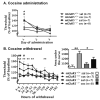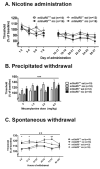Involvement of metabotropic glutamate receptor 5 in brain reward deficits associated with cocaine and nicotine withdrawal and somatic signs of nicotine withdrawal
- PMID: 22147259
- PMCID: PMC4010095
- DOI: 10.1007/s00213-011-2578-8
Involvement of metabotropic glutamate receptor 5 in brain reward deficits associated with cocaine and nicotine withdrawal and somatic signs of nicotine withdrawal
Abstract
Rationale: The involvement of metabotropic glutamate 5 (mGlu5) receptors has been suggested in the reinforcing effects of psychostimulants. However, little is known about the role of these receptors in psychostimulant withdrawal.
Objectives: The role of mGlu5 receptors was assessed in the anhedonic and somatic aspects of psychostimulant withdrawal.
Methods: Anhedonia was assessed with the discrete-trial current-intensity intracranial self-stimulation (ICSS) procedure after the termination of cocaine (180 mg kg(-1) day(-1), salt, 3 days, i.p.) or nicotine (40 mg kg(-1) day(-1), base, 28 days, s.c.) administration via osmotic minipumps in mGlu5 receptor knockout (mGluR5(-/-)) and wild-type (mGluR5(+/+)) mice. Somatic signs were assessed during nicotine withdrawal. The effects of the nicotinic acetylcholine receptor antagonist mecamylamine on ICSS thresholds were assessed during chronic nicotine administration.
Results: Nicotine-treated mGluR5(+/+) and mGluR5(-/-) mice demonstrated similar threshold elevations during mecamylamine-precipitated withdrawal compared with their saline-treated counterparts. During spontaneous nicotine and cocaine withdrawal, thresholds in drug-withdrawing mGluR5(+/+), but not mGluR5(-/-), mice were elevated up to 72 h of nicotine/cocaine withdrawal and then returned to baseline, indicating attenuation of withdrawal-induced anhedonia in mGluR5(-/-) mice. Nicotine-withdrawing mGluR5(+/+), but not mGluR5(-/-), mice showed increases in somatic signs compared with saline-treated counterparts.
Conclusions: mGlu5 receptor null mutation attenuates the anhedonic and somatic effects of psychostimulant withdrawal. This attenuated withdrawal in mGluR5(-/-) mice may result from the lack of drug-induced adaptations in mGlu5 receptor function that may occur in mGluR5(+/+) mice with chronic drug administration. Thus, these results suggest the involvement of mGlu5 receptors in psychostimulant dependence and the mediation of the anhedonic and somatic signs of psychostimulant withdrawal.
Conflict of interest statement
Figures



Similar articles
-
Null mutation of the β2 nicotinic acetylcholine receptor subunit attenuates nicotine withdrawal-induced anhedonia in mice.Eur J Pharmacol. 2015 Apr 15;753:146-50. doi: 10.1016/j.ejphar.2014.05.062. Epub 2014 Aug 5. Eur J Pharmacol. 2015. PMID: 25107281 Free PMC article.
-
Role of α7- and β4-containing nicotinic acetylcholine receptors in the affective and somatic aspects of nicotine withdrawal: studies in knockout mice.Behav Genet. 2012 May;42(3):423-36. doi: 10.1007/s10519-011-9511-0. Epub 2011 Oct 19. Behav Genet. 2012. PMID: 22009521 Free PMC article.
-
Interactive effects of the mGlu5 receptor antagonist MPEP and the mGlu2/3 receptor antagonist LY341495 on nicotine self-administration and reward deficits associated with nicotine withdrawal in rats.Eur J Pharmacol. 2007 Jan 12;554(2-3):164-74. doi: 10.1016/j.ejphar.2006.10.011. Epub 2006 Oct 17. Eur J Pharmacol. 2007. PMID: 17113075 Free PMC article.
-
Metabotropic Glutamate Receptor 7 (mGluR7) as a Target for the Treatment of Psychostimulant Dependence.CNS Neurol Disord Drug Targets. 2015;14(6):738-44. doi: 10.2174/1871527314666150529145332. CNS Neurol Disord Drug Targets. 2015. PMID: 26022263 Free PMC article. Review.
-
Cocaine use disorder: A look at metabotropic glutamate receptors and glutamate transporters.Pharmacol Ther. 2021 May;221:107797. doi: 10.1016/j.pharmthera.2020.107797. Epub 2021 Jan 9. Pharmacol Ther. 2021. PMID: 33359590 Review.
Cited by
-
Discovery and development of varenicline for smoking cessation.Expert Opin Drug Discov. 2018 Jul;13(7):671-683. doi: 10.1080/17460441.2018.1458090. Epub 2018 Mar 28. Expert Opin Drug Discov. 2018. PMID: 29587555 Free PMC article. Review.
-
Nicotine self-administration remodels perineuronal nets in ventral tegmental area and orbitofrontal cortex in adult male rats.Addict Biol. 2017 Nov;22(6):1743-1755. doi: 10.1111/adb.12437. Epub 2016 Aug 22. Addict Biol. 2017. PMID: 27549591 Free PMC article.
-
Metabotropic glutamate receptor 5 as a potential target for smoking cessation.Psychopharmacology (Berl). 2017 May;234(9-10):1357-1370. doi: 10.1007/s00213-016-4487-3. Epub 2016 Nov 16. Psychopharmacology (Berl). 2017. PMID: 27847973 Review.
-
Cocaine-induced loss of LTD and social impairments are restored by fatty acid amide hydrolase inhibition.Sci Rep. 2023 Oct 25;13(1):18229. doi: 10.1038/s41598-023-45476-7. Sci Rep. 2023. PMID: 37880305 Free PMC article.
-
Effect of Aggressive Experience in Female Syrian Hamsters on Glutamate Receptor Expression in the Nucleus Accumbens.Front Behav Neurosci. 2020 Nov 23;14:583395. doi: 10.3389/fnbeh.2020.583395. eCollection 2020. Front Behav Neurosci. 2020. PMID: 33328919 Free PMC article.
References
-
- American Psychiatric Association. Diagnostic and statistical manual of mental disorders. 4th, text rev. American Psychiatric Press; Washington, DC: 2000.
-
- Backstrom P, Bachteler D, Koch S, Hyytia P, Spanagel R. mGluR5 antagonist MPEP reduces ethanol-seeking and relapse behavior. Neuropsychopharmacology. 2004;29:921–8. - PubMed
-
- Backstrom P, Hyytia P. Ionotropic and metabotropic glutamate receptor antagonism attenuates cue-induced cocaine seeking. Neuropsychopharmacology. 2006;31:778–86. - PubMed
Publication types
MeSH terms
Substances
Grants and funding
LinkOut - more resources
Full Text Sources
Other Literature Sources

